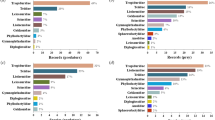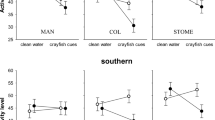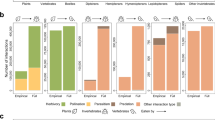Abstract
CERTAIN ecological models1,2 predict that the impact of top predators on plants (producers) usually depends on the number of trophic levels in the food web: with three levels the impact is positive, whereas with four it is negative. These models assume that each of the nonbasal levels eats only the next level down. Indeed, freshwater pelagic systems show the predicted response when a fourth trophic level (piscivorous fish) is experimentally added to a three-level food web3,4. In terrestrial systems, however, the top predator, if insectivorous, typically feeds on more than one trophic level5. This 'closed-loop omnivory'6, which may also characterize certain aquatic systems, necessitates a different model. Anolis lizards are often such top predators on small islands in the Bahamas7, eating both carnivorous and herbivorous arthropods8–10. Numbers of web-spiders on islands without lizards are about 10 times those on islands with lizards11,12 and in experimental enclosures with lizards removed are 3 times those in enclosures with lizards at natural densities13,14. Total leaf damage (by area) to buttonwood (Conocarpus erectus) on islands without lizards is 1.5 times that on islands with lizards15. These results indicate that lizards reduce the overall damage from herbivorous arthropods, even though they also reduce the numbers of web spiders which eat some herbivorous arthropods. Here we report on an experiment with lizards, spiders, herbivorous arthropods and sea grape, that indicates that the impact of top predators on producers depends on the relative strengths of interactions among the upper tropic levels. The impact is predicted to be positive if herbivorous arthropods are more prone to be eaten by lizards than by spiders (Fig. 1, model A) and negative if vice versa (model B). Experimental removal of lizards both increased scar damage on sea grape leaves, produced by homopterans and other organisms, and decreased damage produced by gall midges, indicating that the food web is a composite of models A and B (Fig. 1, model C). Contrary to the experiments in freshwater pelagic systems with four trophic levels, the net effect of top predators on producers was positive, apparently because the model A pathway predominates.
This is a preview of subscription content, access via your institution
Access options
Subscribe to this journal
Receive 51 print issues and online access
$199.00 per year
only $3.90 per issue
Buy this article
- Purchase on SpringerLink
- Instant access to full article PDF
Prices may be subject to local taxes which are calculated during checkout
Similar content being viewed by others
References
Fretwell, S. D. Persp. Biol. Med. 20, 169–185 (1977).
Oksanen, L., Fretwell, S. D., Arruda, J. & Niemala, P. Am. Nat. 118, 240–261 (1981).
Carpenter, S. R. & Kitchell, J. F. BioScience 38, 764–769 (1988).
Persson, L., Andersson, G., Hamrin, S. F. & Johansson, L. in Complex Interactions In Lake Communities (ed. Carpenter, S. R.) 45–65 (Springer, New York, 1988).
Schoener, T. W. Ecology 70, 1559–1589 (1989).
Pimm, S. L. & Lawton, J. H. Nature 275, 542–544 (1978).
Schoener, T. W. & Schoener, A. J. Anim. Ecol. 52, 237–262 (1983).
Schoener, T. W. Ecology 49, 704–726 (1968).
Schoener, T. W. & Gorman, G. C. Ecology 49, 819–830 (1968).
Floyd, H. B. & Jenssen, T. A. Copeia 1983, 319–331 (1983).
Schoener, T. W. & Toft, C. A. Science 219, 1353–1355 (1983).
Toft, C. A. & Schoener, T. W. Oikos 41, 411–426 (1983).
Schoener, T. W. & Spiller, D. A. Science 236, 949–952 (1987).
Spiller, D. A. & Schoener, T. W. Ecol. Monogr. 58, 51–77 (1988).
Schoener, T. W. Oikos 53, 253–266 (1988).
Gagne, R. L. The Plant-feeding Gall Midges of North America (Cornell Univ. Press. Ithaca, 1989).
Johnson, W. T. & Lyon, H. H. Insects that Feed on Trees and Shrubs (Cornell Univ. Press, Ithaca, 1988).
Spiller, D. A. & Schoener, T. W. Oecologia 83, 150–161 (1990).
Pacala, S. & Roughgarden, J. Oecologia 64, 160–162 (1984).
Lawton, J. H. & Pimm, S. L. Nature 272, 189–190 (1978).
Pimm, S. L. Food Webs (Chapman & Hall, London, 1982).
Brown, J. H., Davidson, D. W., Munger, J. C. & Inouye, R. S. in Community Ecology (ed. Diamond, J. M. & Case, T.) 41–61 (Harper & Row, New York, 1986).
Lawton, J. H. in Ecological Concepts (ed. Cherrett, J. M.) 43–78 (Blackwell Scientific, Oxford, 1989).
Hairston, N. G., Smith, F. E. & Slobodkin, L. B. Am. Nat. 94, 421–425 (1960).
Leibold, M. A. Am. Nat 134, 922–949 (1989).
Stein, R. A. et al. in Complex Interactions in Lake Communities (ed. Carpenter, S. L.) 161–179 (Springer-Verlag, New York, 1988).
Sokal, R. R. & Rohlf, F. J. Biometry (Freeman, San Francisco, 1981).
Stevens, J. Applied Multivariate Statistics for the Social Sciences (Erlbaum, Hillsdale, New Jersey, 1986).
Author information
Authors and Affiliations
Rights and permissions
About this article
Cite this article
Spiller, D., Schoener, T. A terrestrial field experiment showing the impact of eliminating top predators on foliage damage. Nature 347, 469–472 (1990). https://doi.org/10.1038/347469a0
Received:
Accepted:
Issue date:
DOI: https://doi.org/10.1038/347469a0
This article is cited by
-
Nonlethal Effects of Predation: The Presence of Insectivorous Birds (Parus major) Affects The Behavior and Level of Stress in Locusts (Schistocerca gregaria)
Journal of Insect Behavior (2023)
-
Feeding habits of Anolis sagrei, an introduced species, in urban ecosystems of Guayas Province
Urban Ecosystems (2020)
-
Landscape-level bird loss increases the prevalence of honeydew-producing insects and non-native ants
Oecologia (2018)
-
Dynamics of a intraguild predation model with generalist or specialist predator
Journal of Mathematical Biology (2013)
-
Alien pollinator promotes invasive mutualism in an insular pollination system
Biological Invasions (2011)



